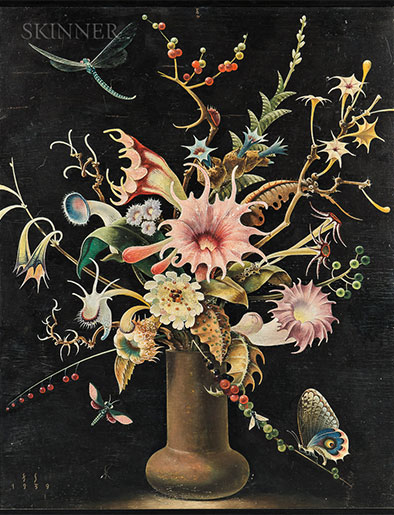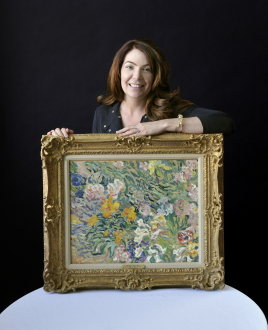As Sir William Gilbert wrote in “The Mikado:” “The flowers that bloom in the spring, tra la, bring promise of merry sunshine.” The sunshine may be fleeting, but those welcome blossoms are the enduring theme of songs, poems and, of course, paintings.
For hundreds of years, floral still lifes have flourished everywhere, from palaces to cottages. There are treasured examples ranging from kindergartener’s refrigerator art to multimillion dollar masterworks. For the next few months flowers will abound everywhere outdoors. All year-round, though, a floral still life brings fresh air into a room of any period, or no period at all.
In the Middle Ages, flowers began to peek out of religious paintings such as altarpieces and the luxurious private prayer books called books of hours. The flowers depicted were highly symbolic — roses for love, lilies for purity. Blossoms weren’t the focus of medieval paintings and tapestries, however. They were included as minor elements, supporting players in a story of faith.
During the Renaissance, flowers came into their own as the main subjects of paintings. Northern European artists excelled in highly detailed, realistic depictions of floral arrangements. These pictures often included unrealistically perfect blooms from different seasons and even different continents, all combined in one gloriously colorful bouquet.
As in medieval floral art, allegories and symbolism were ever-present. Carnations were symbols of love and marriage. Irises represented trust and a divine message. Every flower could convey a hidden meaning, often with a connection to the newly popular classical mythology as well as the Christian faith. For all flowers, the fleeting nature of youth and beauty were definitely part of the picture.
The Baroque, Rococo, Regency and Victorian periods saw the popularity of still life paintings endure even as fashions and painting styles changed. Always a favorite with avocational painters, the still life was also a genre that attracted the skills of professional artists.
Until recent times, European society was governed by strict class boundaries, and the rules were extended to art. The École des Beaux-Arts, perhaps the arbiter of French tastes, imposed a hierarchy on paintings. Its decrees had lingering effects on how artists were trained and how their work was valued.
The highest branch of painting, according to such authority, included historic, religious and mythological subjects. Next came portraits, preferably of the rich, famous and/or beautiful; genre painting or scenes of everyday activities; landscapes; and, at the bottom, still lifes.
To make the point perfectly clear, at the annual salon exhibitions paintings were hung on the exhibit rooms’ walls according to this ranking. Still lifes were usually down at the bottom, emphasizing their inferior status.
None of this did a thing to wither people’s liking for, and acquisition of, floral still-life paintings. Some of the same flowers beloved in the Middle Ages bloomed under the brushes of the Impressionists and Postimpressionists. Pierre Auguste Renoir was especially fond of roses, Claude Monet, water lilies; Vincent van Gogh, sunflowers, irises and almond blossoms.
Successors such as Odilon Redon and Raoul Dufy ushered in a new golden age of floral painting. Twentieth-century examples from American painters like Georgia O’Keefe, Florine Stettheimer and Jane Peterson bloom alongside the color-drenched works of Continental masters such as Emil Nolde, Gustav Klimt and Franz Sedlacek.
The floral still life remains one of the best-loved art genres. Young or old, sophisticated or simple, traditional or avant-garde, everyone is drawn to these paintings. They allow us to enjoy the beauty of spring and summer always, mingled with a promise of growth and renewal that keeps us going through the dark times.
For more, contact Katie at kwhittle@skinnerinc.com or 212-787-1114.


